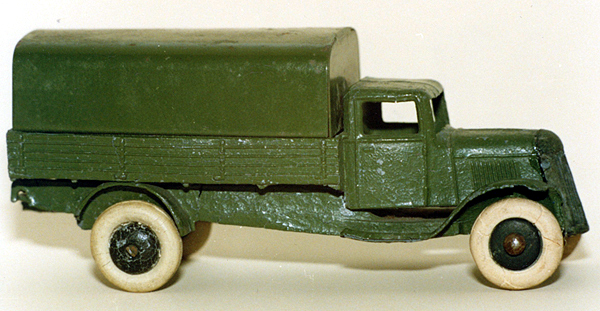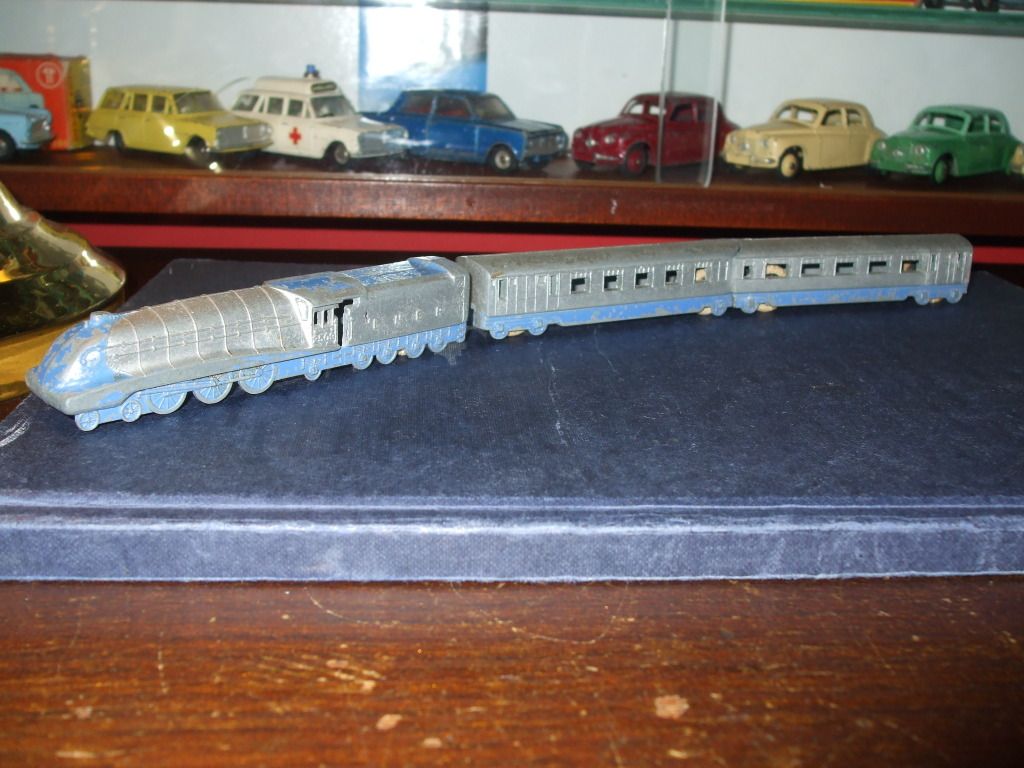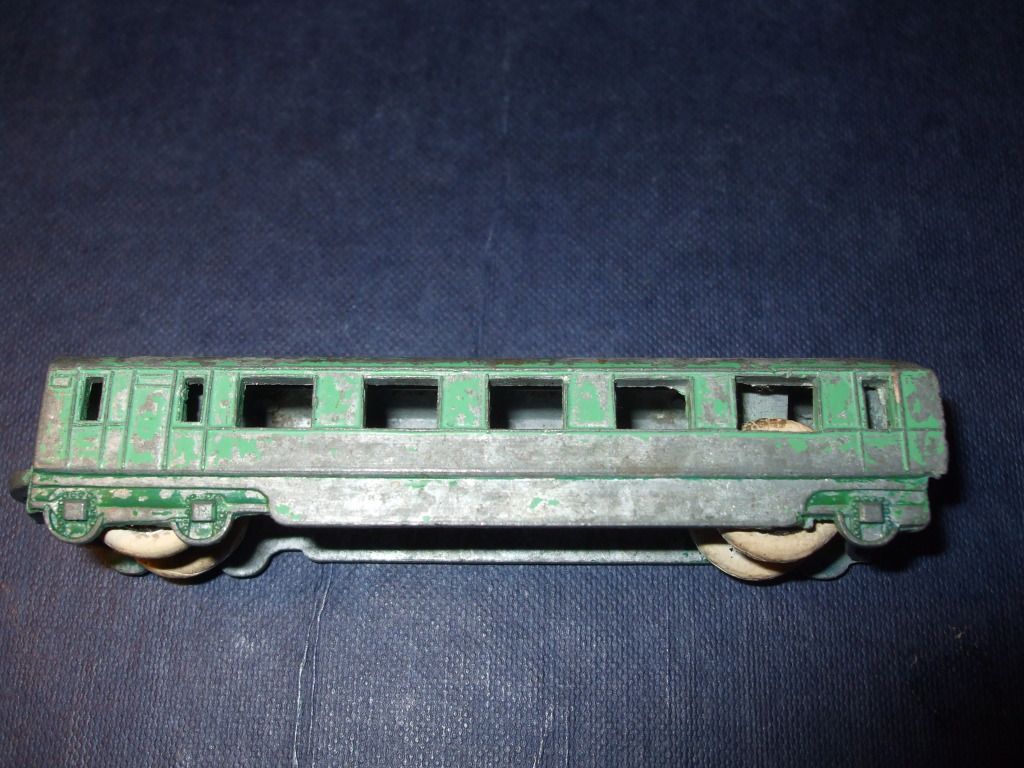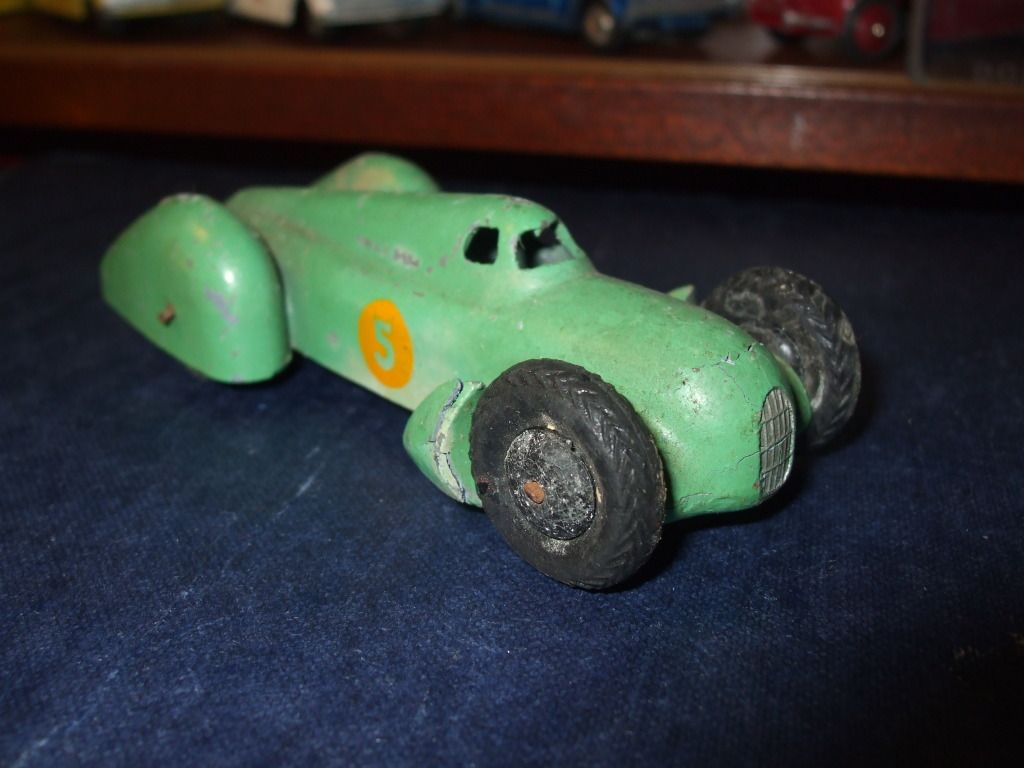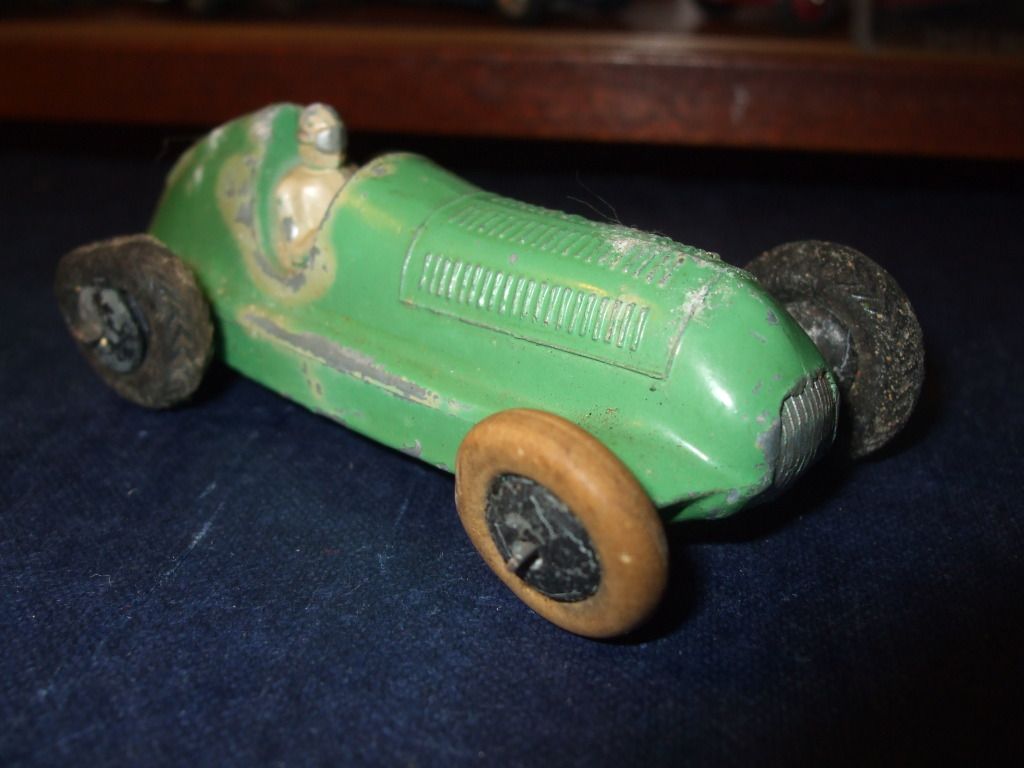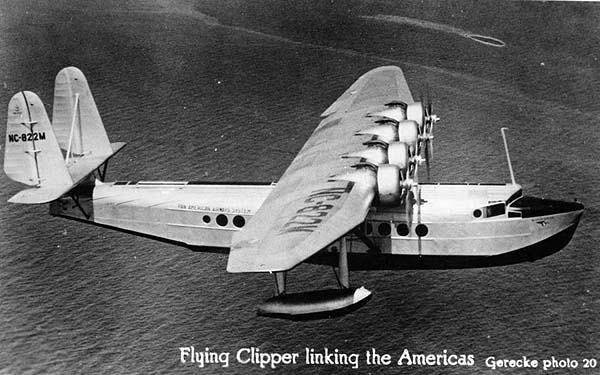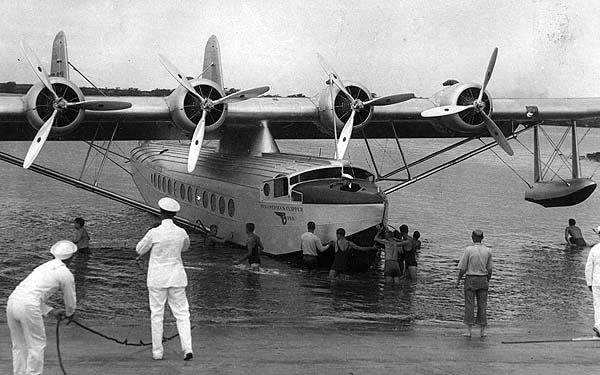- Thank you received: 0
Pre War Models
13 years 1 week ago #11809
by starni999
Replied by starni999 on topic Pre War Models
Please Log in or Create an account to join the conversation.
13 years 1 week ago #11815
by janwerner
Replied by janwerner on topic Pre War Models
Well, Chris, a beauty, OK, of a certain kind! Yes it is definitely an army wagon, in fact a no. 25bm. But I have been enquiring about this model for many years already and I still have never seen or heard of this specific pre-war type. I'm still waiting for someone to report of another example. It is not announced, neither in MM nor in the catalogues as far as I know. My friend is not interested in its scarcity, it's just a dear memory piece for him (of course).
Yes, it is badly fatigued, deformed and fragile. I returned to my friend for making a digital photo of the model some ten years later and found it in this state of continuing deterioration! Kind regards, Jan
Please Log in or Create an account to join the conversation.
13 years 1 week ago #11816
by starni999
Replied by starni999 on topic Pre War Models
Hi Jan, What a terrible shame that this lovely piece is slowly falling apart, I had no idea there was a Pre War military 25 Series, but it makes sense that when Meccano introduced more RAF planes etc in 1939 that more military vehicles would follow, I guess there weren't more as they pretty much sold off the '39 made stock in '40 and went over to war production. I find this whole period facinating,and am always amazed at what turns up, it's what makes the Pre War era so much of a challenge isn't it? I've just picked up a couple of Pre War race cars that were found amongst others in a box in a garage where they had sat for about 75 years, it just goes to show that these are STILL out there......... Chris Warr.
Please Log in or Create an account to join the conversation.
13 years 1 week ago #11832
by starni999
Replied by starni999 on topic Pre War Models
Please Log in or Create an account to join the conversation.
13 years 5 days ago #11841
by starni999
Replied by starni999 on topic Pre War Models
Please Log in or Create an account to join the conversation.
13 years 5 days ago #11842
by dinkyfan
Replied by dinkyfan on topic Pre War Models
Chris--Both of those look to be in quite good condition...wonderful find! Terry
Please Log in or Create an account to join the conversation.
13 years 4 days ago #11843
by janwerner
Replied by janwerner on topic Pre War Models
Nice acquisitions! Sometimes I like the exciting pioneer stories behind as much as the pre-war models themselves. This is (a part of) the story behind the no. 60w 'Clipper III' Flying Boat, one of my favourite pre-war aircraft models:
The model was introduced in 1938, in the glory days of Dinky Toys aircraft models. The aviation scene was very exciting indeed in those days. Pioneer trans-oceanic crossings were made and stunning records were broken, in an era in which flying was anything but common for the ordinary people. This flying boat was of medium size, compared with other Dinky aircraft models. Still, the construction was rather complicated. A separate wing was rivetted to the main part, consisting of the fuselage, wing pylon and tail, including the two vertical rudders. The real one was even more complicated, the main wing being supported by a system of supports, keeping it in balance on top of the extremely narrow pylon top. The prewar version had a flying game eye, protruding down throught the fuselage, next to the single red plastic roller and the two rivets keeping the wing attached to the fuselage. The name was Pan American Airways Clipper III underneath, but post-war the cast-in name was changed into simply Flying Boat. Although registration numbers often seem to have been applied by transfer technique, this one appears to have been stamped on the wing. The surrounding beading if the letters and numbers prove that this one is stamped on. By the way, Ramsays mentions a second version, not showing USA NC16736, but showing NC16736 only, which is said to be a special US issue. The model was packed in such a nice faint blue pre-war lid box, with explanation on the lid. It is a model of a Sikorsky (not famous for helicopters yet) S42B (and not S-24-B as stated in Sue Richardsons reference work, or S32 as stated in Ramsays 11th ed.). The model also came as a part of the set box no. 65, the Presentation Aeroplanes Set, including nos. 60r, 60t, 60v, 60w, 62n, 62p, 62r and 62w, which was available 1939-1941. Undoubtedly for those who followed aviation in the 1930s one of the reasons to model this aircraft was the famous transatlantic crossing, as referred to on the box lid. But things were not that easy as stated in those two lines on the box. There were some obstacles for transatlantic crossings these days. The main obstacle was that Britain did not want the United States to have a monopoly or even a head-start on a transatlantic airline service, and refused to grant landing rights in Britain itself or the British-controlled stepping stone across the Atlantic, such as Atlantic Canada and Bermuda. Similar rivalry from Portugal also frustrated attempts to inaugurate a southern route with stops in the Azores and Lisbon on the southern route. The British insisted on reciprocity, and would not grant landing rights to an American airline until Britains Imperial Airways was able to commence a similar service. On January 25, 1936, Juan Trippe and George Woods-Humphrey, Managing Director of Imperial Airways, signed an agreement dividing transatlantic service between Pan American and Imperial Airways; the agreement eliminated competition from other airlines, such as the Dutch, French, and Germans, who were barred from the British stepping stones across the Atlantic, but it provided that neither Pan Am nor Imperial Airways could begin service until both airlines able to do so. Since Britain was far behind America in flying boat technology, and Imperial Airways did not have any aircraft capable of transatlantic service in 1936, Pan American would have to wait more three years before its planes could fly the Atlantic. The first crack in the wall of British resistance occurred in early 1937, under the threat of competition from airships and alternative technologies, such as the German sea-air catapult mail service, which did not require landing permits on British-controlled territory. Pan Am began construction of flying boat bases Baltimore, New York City, and Port Washington, Long Island, and other bases were built at Shediac, in the Canadian province of New Brunswick; Botwood in Newfoundland, not far from Gander Lake; and at Foynes, on the River Shannon in Ireland. The Clipper III as the name indicates was not the only Clipper, a name that was used frequently for PanAm planes. The first Clipper, the S-40 was delivered to Pan Am on October 10, 1931. It was flown to the Anacostia Naval Air Station at Washington D.C. to be christened by Mrs. Herbert Hoover the American Clipper. After Mrs. Hoover smashed a bottle of water from the Caribbean on the nose of the plane, Trippe called it a flagship, and the first American example of the great airliner of tomorrow that will speed trade and good will among nations. The Clipper designation was born.
The Clipper III was manufactured by the Vought-Sikorsky Aircraft Division of the United Aircraft Corporation in Stratford, Connecticut. The S-42 first flew on March 30, 1934. A total of 10 aircraft were built. These were the first of the great Pan American Airways Clipper Flying Boats and the first true over ocean transport. Model S42A upgraded engines, an improved airfoil, an increased wingspan, a stronger and lighter aluminum alloy skin, a larger gross weight and useful load and convertible sleeping accommodations for 14 passengers; Four aircraft built to this configuration. The Model S42B, the Dinky Toy, made additional aerodynamic improvements, increase in gross weight, improved fuel capacity and thus distance, and the addition of constant speed propellers enhanced the performance. Only Three were built to this configuration. The Sikorsky S-42 is regarded as the first truely American seaplane and was described as the most beautiful aircraft of its time. (many of these words are not my own wisdom, for more details see:
www.flyingclippers.com/S42.html
and
www.clipperflyingboats.com/
) Kind regards, Jan
Please Log in or Create an account to join the conversation.
13 years 4 days ago #11844
by dinkyfan
Replied by dinkyfan on topic Pre War Models
JanWhat a wonderful story about the origins of the Clipper flying boats. I have seen some other articles that went into some depth on the planes themselves and the service that was offered and it was amazing......it sure would have been interesting to fly across the Atlantic in one.And your model is just lovely, along with that beautiful box...very nice! Again, it appears that Dinky did a very good job of replicating with their model. Terry
Please Log in or Create an account to join the conversation.
13 years 4 days ago #11845
by Richard
Replied by Richard on topic Pre War Models
Thank you Jan for this very interesting article. it's really a beatiful Dinky !
Please Log in or Create an account to join the conversation.
13 years 3 days ago #11846
by starni999
Replied by starni999 on topic Pre War Models
Wonderful model Jan, great story behind it too! CW.
Please Log in or Create an account to join the conversation.
13 years 3 days ago #11848
by dinkyfan
Replied by dinkyfan on topic Pre War Models
Just received a new pre-war model for my Dinky collection....a very nice 23a Racing Car. I am certainly not an expert on this model, but have read the usual resources and found out that there were several versions. The earliest one, introduced in 1934, had the 4 stub exhaust pipes....2 on each side of the hood, and no driver. Around 1935, the second version was introduced, this having the more familiar 6 branch exhaust system on the left side of the hood, and exiting in the 'fishtail' style pipe at the rear. A driver's head was also added, along with cast 'roundals' to locate a painted racing number. Another early indicator, according to 'Dinky Toys and Modelled Miniatures', by Mike and Sue Richardson, was the open area directly behind the windscreen. As Dinky frequently did, this was a problem in casting, and was very soon filled in. Mine seems to have this open area, so from all of that I am dating it around 1935 or 1936. The condition I think is very good to excellent, with no fatigue showing anywere, and the white tires are very clean and hardly cracked. It must have sat in a box for a very long time. Any other information or comments from those far more knowledgeable than I are welcomed!Terry
Please Log in or Create an account to join the conversation.
13 years 2 days ago #11849
by buzzer999
Replied by buzzer999 on topic Pre War Models
Hi Terry That racing car is a real beauty - what a find!!! Dave
Please Log in or Create an account to join the conversation.
Time to create page: 0.789 seconds


